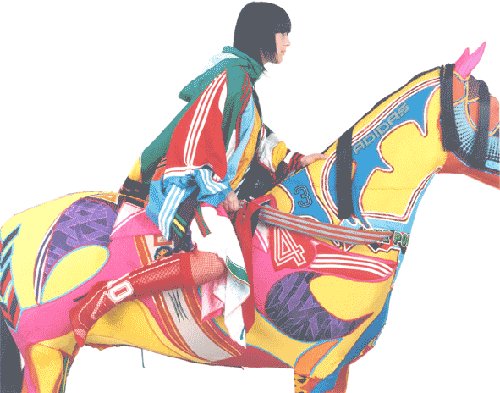17/11/2004
Two shows
AP4-ART, Geneve
Swetlana Heger's work examines a fundamental contradiction in art in advanced capitalism, realized in the tenacity of a deep individualistic aesthetic ideology. Agnieszka Brzezanska's paintings have a somewhat more abstract character; they can be interpreted as a process-like appropriation and deletion of reality.

Swetlana Heger / Agnieszka Brzezanska
Swetlana Heger
Not so long ago to claim that business was the highest form of art, as Andy Warhold did, was regarded as a provocation. But today it appears as art has become the highest form of business – the model for a new consumer society.
……In the face of the progressive market saturation, and hence in the view of the problem that the main problem has become how to sell goods rather than how to produce them – those anti establishment values articulated by the artists in their attempted critique of capitalism have themselves gradually become commercialized when faced by the profit motive…..The new consumer market released art from the realm of culture to subordinate it to commerce and to large advertising agencies, seeking to sell ready to use lifestyles….And it is certainly not by chance that art, fashion, and lifestyle magazines look more and more alike…..
…maybe more than any other artist today, Heger uses the new economical data as both a frame and a material for her work. Playtime, a continuing project, is meant explicitly to promote the artist Swetlana Heger like an actual brand. To do that she hired the skills of an identity and marketing consultancy which is meant to be as responsible for the development of Swetlana Heger brand as the artist herself. For that matter, artists defined some categories fields-actually marketing categories- defining what could be the identity of the product Swetlana Heger : individuality, mobility, publicity, economy, technology, culture, family, design, sexuality, food , community, environment. Each of these categories has been pitched to different firms ….which hope to sell their own products by promoting the product artist Swetlana Heger and, in so doing, contribute to the construction of her brand identity. They support the project by providing their own products and by contributing financially to the production costs. The brand names and their logos appear in the title of the works as well as in the actual piece of art. Their ware could be exchanged for an advertising spot on the Playtime piece, actually an installation platform, which is displayed by the artist as a stage set for the photo shoot, in a way very close to what can be seen in some fashion or lifestyle magazines. A second part of Playtime consists of an image campaign for herself and her campaign, using young professional designers, photographers, and make up artists. (She has collaborated with companies such as Adidas, Levis, and Hermes, among others, making herself a model for all these firms, with poses reminiscent of famous historical art works).
Heger’s work…. examines a fundamental contradiction in art in advanced capitalism, realized in the tenacity of a deep individualistic aesthetic ideology in a world that is organized entirely according to the needs of collective social production ( of goods and taste)……
Heger suggested that Brand Art might be a successor to pop art. As so many people keep asking at which point the position of pop in the art field was compromised, the probability exists that the new product labeling will now start another long line of misunderstandings in terms of its relationships to corporate culture.
Vincent Pécoil, Brand Art, On Art after Warhol, Art Monthly, April 2003
Agnieska Brzezanska
……Following on the heels of conceptual and minimal art, Bruce Naumann initiated an uncompromising paradigm shift with his neon spiral sign "the true artist reveals mystical truth". If the twentieth century - as a reaction to Freud's subconscious - came to epitomise individual awareness and logic, the twenty-first shows signs of becoming a century determined by individual psychological influences. Relationships between human beings, the "trans-individual", the transcendental and the mystical seem to offer interesting access points to an ever more complex reality….
If one passes the various work groups that have sprung up around Agnieszka Brzezanska in recent years in review, what they have in common is the search for the mystic in everyday life. …..
……."But beauty saves the world," postulated Dostoyevsky. Agnieszka Brzezanska's works revolve around beauty like moths around the flame of a candle. "Double happiness" (works 2000-2002 from the show at "Zacheta" national gallery of art and cca "Ujazdowski Castel", Warsaw) is the title of a series of pictures that she took from glossy magazines and adapted to her own ends. She superimposed a series of pictures with Tibetan gods, hiding their godly status behind masks, in order to make visible the interferences in the fields of power between our modern designer tsars, Gauthier, Kenzo, Chanel, Gucci, and the samsaric existence of Tibetan gods, the demi-gods, the animals, the hungry spirits and creatures from hell……
In Tibetan visualisation counts as an aid to meditation, mantras are considered to assist concentration and trance-like states. This is also true of the floral patterns and designs in which Agnieszka Brzezanska clothes her figures. This links the corporeal ecstasy of top athletes or the self-trances of models to the meditation masters……
Brzezanska's paintings have a somewhat more abstract character. They can be interpreted as a process-like appropriation and deletion of reality. Abstract patterns and flowing female figures appear to be the embodiment of an all-pervading energy…..It appears we are dealing with a form of energy that, detached from individual sensibilities in the shape of a human being, flows back into the world…..
Claudia Jolles, Editor in Chief of Kunst-Bulletin, Escaping the agony of understanding, Meridian Nr. 14, Summerterm 2004, Zürich
Image: Swetlana Heger
Opening November, 18 6-9pm
AP4-ART
1, Rue du Tir, Geneve



